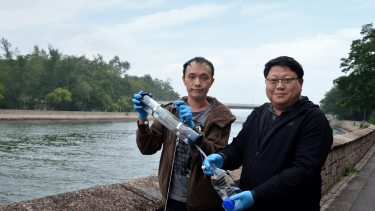Global Study on Widespread Pharmaceutical Contamination in Rivers Named One of the Best Papers in PNAS 2022

Sponsored by

Sponsored by

Professor Kenneth Mei Yee Leung and his former postdoctoral fellow, Dr Racliffe Weng Seng Lai participated in the global project which is about pharmaceutical pollution of the world’s rivers.
Scholars at the City University of Hong Kong participated in the leading global monitoring of pharmaceutical pollution in the aquatic environment
A global study has found that many of the world's rivers, including two in Hong Kong, are widely contaminated with common pharmaceuticals. Professor Kenneth Mei Yee Leung, Chair Professor in the Department of Chemistry and the Director of the State Key Laboratory of Marine Pollution (SKLMP) at the City University of Hong Kong (CityU), and his former postdoctoral fellow, Dr Racliffe Weng Seng Lai participated in this global project co-led by Professor Alistair B.A. Boxall and Dr John L. Wilkinson from the University of York in the United Kingdom.
Their paper entitled “Pharmaceutical Pollution of the World’s Rivers”, published in The Proceedings of the National Academy of Sciences (PNAS), has been awarded the 2022 Cozzarelli Prize in the Class VI: Applied Biological, Agricultural, and Environmental Sciences. The prize is presented to six research teams annually to recognise the significant contributions of their PNAS publication to their respective research fields. Each team represents one of the six National Academy of Sciences (NAS) classes.
Current researchers are confronted with a significant challenge that only 75 of 196 countries have assessed pharmaceutical contamination in the aquatic environment, with most research conducted in North America and Western Europe, leaving large geographical regions understudied.
“The previous related studies touched only on the ‘tip of the iceberg’,” Leung says. He explains that these studies employed different analytical methods and monitored different pharmaceuticals. Cumulatively, this has made it difficult to quantify the scale of the problem from a global perspective and leaves a substantial knowledge gap and uncertainty about the actual rate of pharmaceutical pollution around the world.
This study is the first and the most extensive global monitoring effort, covering all seven continents, 137 countries and regions, and 258 rivers. “The standardised method we adopted in such research allowed a fair global comparison for the first time. We were delighted to play a part in this meaningful project, contribute to sample collections in Hong Kong and Bhutan, and make statistical analyses of the data.” Leung adds.
The study revealed that levels of at least one drug measured in this research were higher than the safe level for aquatic organisms or could contribute to antibiotic resistance in more than a quarter of the sites investigated.
Statistical analyses conducted by Leung and Lai also identified a strong correlation between the socioeconomic status of a country or region and the level of pharmaceutical pollution in its rivers. Rivers in lower-middle-income countries were found to be the most polluted. It revealed that socioeconomic status and human health may be the key predictors of local environmental pollution levels for pharmaceuticals.
Many Asian countries and regions generally demonstrated higher levels of pharmaceutical contamination than other countries. After analysing water samples from Hong Kong rivers, Leung’s research team found that the Kai Tak River and the Lam Tsuen River had detectable concentrations of multiple pharmaceuticals, and their overall level of contamination ranked them as the 29th and 70th most polluted rivers, respectively, among the 258 sampled rivers globally. 34 different pharmaceuticals were detected in one of the samples of the Kai Tak River, which was the highest number of detectable pharmaceuticals in this global study.
“The study identified rivers with high pharmaceutical contamination and high-risk chemicals. With such information, it is possible to formulate practical and integrative strategies from legislation to education and pollution control, to minimise the release of these chemicals to the rivers across the globe, eventually making the rivers ‘cleaner’.” Leung remarks.
Inspired by this study, a new global project, the Global Estuaries Monitoring (GEM) Programme, was launched and endorsed as an “Ocean Decade Action” under the United Nations Decade of Ocean Science for Sustainable Development (2021-2030) in June 2021. The GEM Programme, led by Leung and the Department of Chemistry at CityU, will investigate pollutants in major estuaries around the world, including pharmaceutical residues.
Find out more about the Department of Chemistry at the City University Hong Kong.